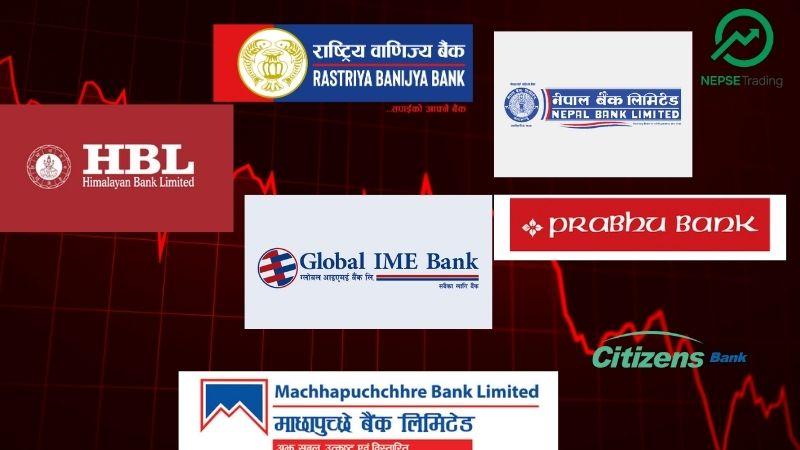By NEPSE TRADING
Gen-Z Protests Inflict Heavy Damage on Nepal’s Banking Sector, Governor’s Residence Targeted

The ongoing Gen-Z protests, which began on September 8, 2025 (Bhadra 23, 2082 BS), have escalated into one of the most disruptive movements Nepal’s financial sector has faced in recent history. Initially launched as a campaign against corruption and inequality, the protests have turned violent, with banks, ATMs, vehicles, and government offices becoming prime targets.
Direct Impact on Banks and Financial Institutions
Several commercial banks have reported significant physical damage:
Agriculture Development Bank (ADBL): One employee, Ashok Shrestha, was shot in the head while working at the central office in Kathmandu. He underwent emergency surgery at Annapurna Hospital, where the bullet was successfully removed. Additionally, the bank’s Kirtipur ATM was vandalized, and branch offices in Lahan and Dhangadhi sustained damages.
NIC Asia Bank: Reported damage to 14 ATMs, 5 branch offices, and 6 service counters. Deputy CEO Santosh Kumar Rathi confirmed that although infrastructure was destroyed, no cash was stolen, and all employees remained safe.
Kumari Bank: Glass windows at the Dulegaunda branch were shattered in stone-pelting incidents, while an ATM located within Hetauda’s Bhatbhateni complex was heavily damaged.
Himalayan Bank: The Battisputali branch was completely burned to ashes, though vaults and lockers remained intact. ATMs in New Road, Bhairahawa Airport, Kamaladi IT Plaza, Hilton Hotel premises, and Bhatbhateni outlets in Biratnagar and Butwal were also damaged.
Global IME Bank: Its Central Trade and Internal Audit departments inside Kantipur Building were damaged by arson. Several government revenue collection counters operated by the bank, including those at the Inland Revenue Department, Department of Transport, and Land Revenue Offices, were vandalized.
Rastriya Banijya Bank: Branches in Baneshwor, Duhabi, and Bhairahawa, along with ATMs, were damaged.
Nepal Bank: Reported destruction at counters in Kakarbhitta, Gauradaha, and Taplejung, as well as one ATM machine.
Machhapuchhre Bank: ATMs located at Bharatpur Malpot Office, Singha Durbar, and the Commission for the Investigation of Abuse of Authority were damaged.
Citizens Bank: An ATM in Naxal’s Bhatbhateni complex was attacked.
Prabhu Bank: Reported vandalism at its Lainchaur branch.
Attack on the Governor’s Residence
One of the most symbolic incidents was the attack on Nepal Rastra Bank Governor Dr. Bishwo Poudel’s residence in Bhaisepati. Protesters accused him of being politically appointed due to ties with the Nepali Congress and set his home on fire. According to Governor Poudel, the attackers not only destroyed household property but also burned rare historical artifacts, religious idols, and valuable books. His family, including his wife and nine-year-old daughter, narrowly escaped the violence.
His old home in Chitwan was also vandalized.
A Blow to Financial Stability and Investor Confidence
The protests highlight deep public frustration with corruption and governance, but the targeting of financial institutions poses severe risks to Nepal’s economic stability.
Short-Term Impact:
Banks face operational paralysis in several cities due to damaged infrastructure.
Customers are experiencing disruptions in cash withdrawals and financial transactions, especially in areas where ATMs were destroyed.
Confidence in the physical security of financial institutions has been shaken.
Medium-Term Impact:
Repair and reconstruction will require millions in recovery funds, putting pressure on banks’ balance sheets.
Insurance claims and litigation could rise, delaying business continuity.
The perception of lawlessness may discourage both domestic and foreign investors.
Long-Term Risks:
If political instability persists, Nepal risks capital flight and a decline in FDI inflows, particularly in banking and infrastructure projects.
Confidence in the Nepal Rastra Bank, the country’s financial regulator, has been damaged due to the personal targeting of the Governor.
The incident could also undermine Nepal’s creditworthiness and global reputation as a safe investment destination.
The destruction of banks, government revenue counters, and police offices signals a direct attack on state functionality. Without immediate restoration of security and public trust, Nepal risks spiraling into financial disorder, where essential government revenue collection and financial services may halt, affecting ordinary citizens most severely.
The Gen-Z protests have moved beyond political expression to economic sabotage. While the movement’s roots lie in calls for transparency and anti-corruption, its violent turn threatens to undo Nepal’s fragile economic recovery. Policymakers now face the dual challenge of restoring law and order while addressing the underlying grievances that fuel such widespread anger.









